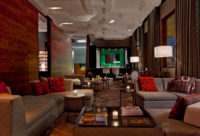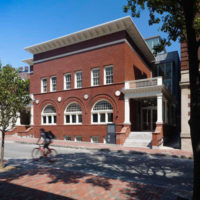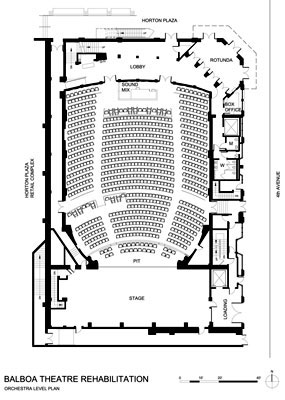Balboa Theatre

Photo © Nels Akerlund Photography

Photo © San Diego Historical Society

Photo © Nels Akerlund Photography

Photo © Nels Akerlund Photography

Photo © Nels Akerlund Photography

Image courtesy Westlake Reed Leskosky

Image courtesy Westlake Reed Leskosky

Image courtesy Westlake Reed Leskosky

Photo © Nels Akerlund Photography

Photo © Nels Akerlund Photography

Image courtesy Westlake Reed Leskosky











The restoration of the Balboa Theatre, bordering the Gaslamp Quarter Historic District in San Diego, California, recreates the vaudeville-era theatre and movie house to its original 1924 design, while transforming it into a modern performing arts center that accommodates diverse performance programs, as well as community, corporate, and convention gatherings.
Listed on the National Register of Historic Places, the 1,339-seat live performance theatre in the heart of downtown has been renovated under the direction of the Centre City Development Corporation (CCDC), a public, nonprofit corporation created by the city of San Diego for the redevelopment of 1,500 acres downtown. CCDC renovated the landmark located within the Horton Plaza redevelopment project area, succeeding after numerous attempts to make it viable though private developers had failed. The rebirth of the Balboa – a structure that blends Mediterranean Classicism with Moorish and Spanish revival styles, and one of America’s last surviving and un-restored historic theatres of its scale to be preserved – exemplifies how preservation and reinvestment contributes to the reinvigoration of communities.
A 22-year effort and comprehensive $26.5 million phased project solved space constraints and technical complexities, including a unique seismic retrofit, precise fitting of the program, and forensic paint analysis revealing a palette of lavender and metallic bronze. The scope of the design encompasses the restoration of the exterior rotunda, lobbies, and the audience chamber and balcony, including new, wider seating and the restoration of the theatre’s decorative ceiling and walls, original chandeliers, and indoor waterfalls. New mechanical, electrical, and theatre performance systems such as rigging, lighting, and audio/visual technology, were installed.
Using a digital printing process, and based on a historic photograph, a new house curtain and grand drape valance were created in the style of the original. Lobby, box office, loading area, and public amenities were improved and expanded. Enhancements also include an accurate recreation of the exterior blade sign, entry marquee, and storefronts, and the addition of an orchestra pit lift and orchestra side shell panels. The building’s structure was reinforced for seismic stability.
PeopleOwner Gary J. Bosse, P.E. Eli Sanchez Theatre Operations: Donald M. Telford Owner’s Representative: Karen Neu O’Connor, Project Manager Architect Westlake Reed Leskosky Personnel in architect's firm who should receive special credit: Associate Architect, Preservation Consultant: David Marshall, AIA, President Interior designer Fonda Hosta, NCIDQ Certified, Associate Principal, Interior Design Engineer(s) V. Mitchell Lyles, P.E., Principal, Mechanical Engineer Megan Gezze, Mechanical Engineer David D. Woytek, Jr., Associate, Electrical Engineer Joe Borzyn, P.E., Electrical Engineer Jason Clausen, Electrical Designer/Construction Administration Structural Engineer: Tony Court, Structural Engineer Civil Engineer: Larry Thornburgh Consultant(s) Scottsdale, Arizona Code Consultant: Garner A. Palenske, P.E., Vice President, Manager Utility Coordination: Jany Staley Abatement Consultant: Brendan Phelan Ornamental Paint Analysis: Jeff Greene Theatre Seating: Jack Bogan General contractor Ankit Sanghvi, Project Manager Jeff McDonald, Superintendent Tiffany Whipple, Project Engineer Photographer(s) Existing and “before” photography courtesy of Heritage Architecture & Planning
|
ProductsStructural system Interior finishes Furnishings Seat Fabric: Lighting Historic Lighting Restoration: Specialty Lighting: Add any additional building components or special equipment that made a significant contribution to this project: Stage Rigging and Motorized Acoustic Drapery: Paint: Theatrical Wiring Devices and Theater Dimming System: Supplier: Organ and Orchestra Pit Lifts: AV Systems Supplier/Installer:
|















